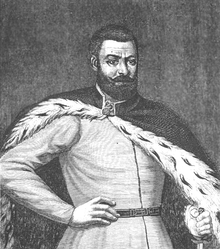Loading AI tools
Lithuanian military officer From Wikipedia, the free encyclopedia
Hrehory Chodkiewicz (Lithuanian: Grigalius Chodkevičius, Ukrainian: Григорій Олександрович Ходкевич, romanized: Hryhorii Oleksandrovych Khodkevych; c. 1514 – 9 November 1572) was a Ruthenian noble and military officer of the Grand Duchy of Lithuania. He was a son of Aleksander, brother of Hieronim and Yurii, and uncle of Jan Hieronimowicz Chodkiewicz. He commanded the Grand Ducal Lithuanian Army during the latter part of the Livonian War after he had become the Grand Hetman of Lithuania in 1566.
Hrehory Chodkiewicz | |
|---|---|
 | |
| Coat of arms | Kościesza (Chodkiewicz) |
| Born | c. 1514 |
| Died | 9 November 1572 (aged 57–58) |
| Noble family | Chodkiewicz |
| Spouse(s) | Katarzyna Wisniowiecka |
| Issue | Anna, Aleksandra, Andrzej, Aleksander, Zofia |
| Father | Aleksander Chodkiewicz |
| Mother | Wasylissa Jaroslawowiczówna Hołowczyńska |
Chodkiewicz was long held to have been born around 1505.[1] However, Lithuania historian Genutė Kirkienė noted that in such a case Chodkiewicz began his political career in his mid-forties, when most nobles started in late twenties or early thirties. Kirkienė suggested that his father's marriage and birth of children should be moved from 1500s to mid-1510s.[2] As a young boy Chodkiewicz was sent to the court of Albert, Duke of Prussia. He returned in 1532 with personal recommendation letters from Albert to King Sigismund I the Old, Prince Sigismund II Augustus and Queen Bona Sforza.[3] The relationship and correspondence with Albert continued for decades; Chodkiewicz sent both of his sons to be educated at Albert's court.[4]
He received his first position at the court in October 1544 when incoming Grand Duke Sigismund Augustus made a series of new appointments and elevated Chodkiewicz to court chamberlain (podkomorzy).[5] Soon, however, the Chodkiewicz family fell from royal grace when they opposed the marriage between Sigismund Augustus and Barbara Radziwiłł. It seems that Hrehory Chodkiewicz remained close with Sigismund Augustus and often accompanied the Grand Duke to hunting.[6] After his father's death in 1549, he inherited Supraśl and surrounding territories, including Zabłudów and Choroszcz. Chodkiewicz family slowly regained royal favor after Barbara's death in 1551 and when other Radziwiłłs opposed the proposed Union of Lublin in 1562.[7]
As voivode of Kiev, Chodkiewicz defended the region from Tatar invasion. In 1558, he achieved a victory in Podolia against the Crimean Khanate.[8] This victory raised prestige of Chodkiewicz as a military commander. On the onset of the Livonian War, he was promoted to castellan of Trakai with intention to use his skill in the war.[9] In 1561, Grand Hetman Mikołaj "the Black" Radziwiłł, Chodkiewicz, and his brother Hieronim led the Lithuanian army into Livonia where they achieved victory against the Tsardom of Russia.[4] After this campaign, Chodkiewicz was promoted to Field Hetman of Lithuania. On 20 January 1564 the Lithuanians under his command killed Russian commander Shuisky and defeated the Russian army in the Battle of Ula, which significantly improved Lithuania's standing in the war.[10] He was hailed as war hero and promoted to castellan of Vilnius.[11] Royal favor continued: Hrehory's nephew Jan Hieronimowicz received his late father's position as Elder of Samogitia in 1564, brother Yurii, who traveled to Moscow for diplomatic negotiations, became castellan of Trakai and Hrehory was appointed Grand Hetman of Lithuania in 1566.[12] Thus, Hrehory Chodkiewicz became the second man after Mikołaj "the Red" Radziwiłł and the Chodkiewiczs controlled three out of five top seats in the Lithuanian Council of Lords.[12] In 1567, Chodkiewicz achieved another victory in Livonia, this time against the Kingdom of Sweden.[4]
Chodkiewicz devoted much attention to military matters. In 1562 and 1566, he wrote military regulations, which dealt with defense of fortresses and other matters.[13] He also built and strengthened a number of border posts and conducted the military census of 1568 to determine how many troops each noble had to provide for the army. In 1563 Chodkiewicz founded an Eastern Orthodox church and a hospital for the poor in Zabłudów. Kirkienė found hints that Chodkiewicz was not strictly Orthodox and supported church union—eastern liturgy under the Pope in Rome.[14] In 1566, Chodkiewicz sponsored Pyotr Mstislavets and Ivan Fyodorov, book printers who defected from Russia, and opened a printing press in Zabłudów. They published religious texts until Chodkiewicz's death.[4]
Chodkiewicz held the following positions:[8]
Around 1537, Chodkiewicz married Katarzyna from the Wiśniowiecki family who brought many new lands into the Chodkiewicz family. Chodkiewicz sued Konstanty Ostrogski and his son Ilia for various territories belonging to his wife.[16] They had two sons and three daughters. The sons had no heirs and the Supraśl line of the family became extinct. The possessions passed to Yurii Chodkiewicz, brother of Hrehory.[17] All daughters married members of the Lithuanian Council of Lords. The children were:[18]
Seamless Wikipedia browsing. On steroids.
Every time you click a link to Wikipedia, Wiktionary or Wikiquote in your browser's search results, it will show the modern Wikiwand interface.
Wikiwand extension is a five stars, simple, with minimum permission required to keep your browsing private, safe and transparent.